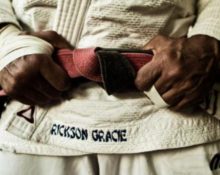Sambo is an international sport, one of the youngest, but actively developing. Included in the list of Olympic disciplines. All fighters in this area are divided by age (7 categories), weight and skill level. An indicator of the latter is the belt, or rather, its shade. Moreover, regardless of the tone, the belt is always sewn from cotton, just like the jacket.
Sambo belts in order and color
 White - the beginning of the beginning. It is intended for all beginners who have not yet developed the skills to pass the test to confirm a qualifying degree. After moving to a new level of skill, a belt of a different shade is issued. The color depends on the type of certification and the level of personal progress of the athlete.
White - the beginning of the beginning. It is intended for all beginners who have not yet developed the skills to pass the test to confirm a qualifying degree. After moving to a new level of skill, a belt of a different shade is issued. The color depends on the type of certification and the level of personal progress of the athlete.
Important! Each category has its own list of minimum requirements. The athlete must be able to perform a certain technique, know the starting stance and get into it in a timely manner, and also move as intended. Moreover, all the names of the techniques are pronounced and memorized not in Russian.
Youth categories
The initial level is 6 KYu or Rokukyu. The degree is awarded by the club or circle itself, provided that the examiners - at least 2 people - have the necessary qualifications (1st KYu and above). Belt color: white.
Important! The status and position of the certifying person is retained only for a year. If within 12 months he has not confirmed his level in one way or another, then his right to conduct exams is eliminated.
 The test for the assignment of 2nd youth rank is carried out under the same conditions as set out above, but the shade of the issued belt changes to yellow. In the register this level is designated as 2nd student degree, gokyu or 5th kyu.
The test for the assignment of 2nd youth rank is carried out under the same conditions as set out above, but the shade of the issued belt changes to yellow. In the register this level is designated as 2nd student degree, gokyu or 5th kyu.
1st junior category, 4th KYu or 3rd student degree is also awarded by the school’s management team. Awarded belt color: orange.
Next comes green belt. This is the 4th academic degree or 3rd category according to the EESC. Blue bearers are holders of the 2nd category or 5th academic degree.
Important! A green or blue belt cannot be obtained by demonstrating your skills to the leadership of your home school or club. It is necessary to reach the local, city or district level. In this case, the receiving persons must themselves have a rank of at least 1 DAN.
Applicants for 1st KYu, 1st adult category or 6th student degree are certified at the republican and regional regional level. The qualification of the examiner must be at least 2 DAN. Color of the resulting belt: brown.
Candidate Master of Sports
 At this stage, the method of obtaining the title changes. It is not the demonstration performance before the certifying commission that is taken into account, but the fighter’s personal achievements. 1 DAN, CMS or 1 master's degree is awarded in the following cases:
At this stage, the method of obtaining the title changes. It is not the demonstration performance before the certifying commission that is taken into account, but the fighter’s personal achievements. 1 DAN, CMS or 1 master's degree is awarded in the following cases:
- victory at territorial youth championships;
- 1–3 place at the Russian Junior Championship or at the territorial championship;
- 3rd place at the Russian Youth Championship.
In addition, you can become a candidate for length of service as a coach. To do this, you need to hold a position and systematically take part in competitions at various levels for 3 or more years.. The recipient, in addition, must have 2 or 1 professional category.
If any of the above requirements are met, the athlete is given a new identification mark. Color of the awarded belt: black.
Master of Sports – categories
Athletes level 2 DAN – 5 DAN are assigned black belts. Holders of 6, 7 and 8 DAN wear a red and white identification badge. After assigning the 9th and 10th master's degrees - 9 and 10 DAN, respectively - red belts are used.
Important! The fastest way to obtain 4th to 7th DAN is by participating and winning at the Olympic Games. The slowest is making a contribution to the development of methods and theory of sports.


 0
0





